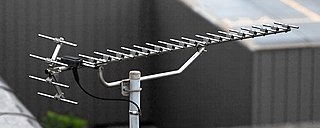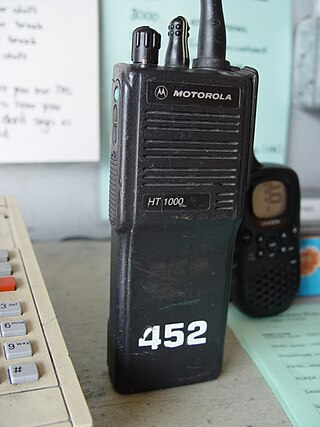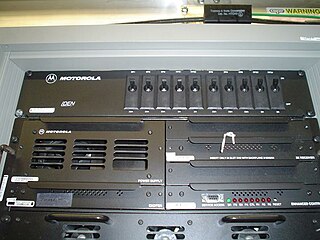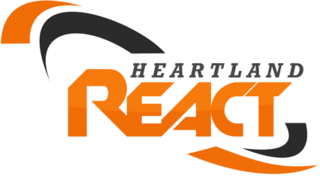Related Research Articles
LPD433 is a UHF band in which license free communication devices are allowed to operate in some regions. The frequencies correspond with the ITU region 1 ISM band of 433.050 MHz to 434.790 MHz. The frequencies used are within the 70-centimeter band, which is currently otherwise reserved for government and amateur radio operations in the United States and most nations worldwide.

Citizens band radio is a land mobile radio system, a system allowing short-distance one-to-many bidirectional voice communication among individuals, using two-way radios operating near 27 MHz in the high frequency or shortwave band. Citizens band is distinct from other personal radio service allocations such as FRS, GMRS, MURS, UHF CB and the Amateur Radio Service. In many countries, CB operation does not require a license and may be used for business or personal communications.

Ultra high frequency (UHF) is the ITU designation for radio frequencies in the range between 300 megahertz (MHz) and 3 gigahertz (GHz), also known as the decimetre band as the wavelengths range from one meter to one tenth of a meter. Radio waves with frequencies above the UHF band fall into the super-high frequency (SHF) or microwave frequency range. Lower frequency signals fall into the VHF or lower bands. UHF radio waves propagate mainly by line of sight; they are blocked by hills and large buildings although the transmission through building walls is strong enough for indoor reception. They are used for television broadcasting, cell phones, satellite communication including GPS, personal radio services including Wi-Fi and Bluetooth, walkie-talkies, cordless phones, satellite phones, and numerous other applications.
Citizens band radio is a system of short-distance radio communications between individuals on a selection of 40 channels within the 27-MHz band. In the United Kingdom, CB radio was first legally introduced in 1981, but had been used illegally for some years prior to that.

A radiotelephone, abbreviated RT, is a radio communication system for conducting a conversation; radiotelephony means telephony by radio. It is in contrast to radiotelegraphy, which is radio transmission of telegrams (messages), or television, transmission of moving pictures and sound. The term is related to radio broadcasting, which transmit audio one way to listeners. Radiotelephony refers specifically to two-way radio systems for bidirectional person-to-person voice communication between separated users, such as CB radio or marine radio. In spite of the name, radiotelephony systems are not necessarily connected to or have anything to do with the telephone network, and in some radio services, including GMRS, interconnection is prohibited.

The Family Radio Service (FRS) is an improved walkie-talkie radio system authorized in the United States since 1996. This personal radio service uses channelized frequencies around 462 and 467 MHz in the ultra high frequency (UHF) band. It does not suffer the interference effects found on citizens' band (CB) at 27 MHz, or the 49 MHz band also used by cordless telephones, toys, and baby monitors. FRS uses frequency modulation (FM) instead of amplitude modulation (AM). Since the UHF band has different radio propagation characteristics, short-range use of FRS may be more predictable than the more powerful license-free radios operating in the HF CB band.

A walkie-talkie, more formally known as a handheld transceiver, HT, or handheld radio, is a hand-held, portable, two-way radio transceiver. Its development during the Second World War has been variously credited to Donald Hings, radio engineer Alfred J. Gross, Henryk Magnuski and engineering teams at Motorola. First used for infantry, similar designs were created for field artillery and tank units, and after the war, walkie-talkies spread to public safety and eventually commercial and jobsite work.

The General Mobile Radio Service (GMRS) is a land-mobile FM UHF radio service designed for short-range two-way voice communication and authorized under part 95 of the US FCC code. It requires a license in the United States, but some GMRS compatible equipment can be used license-free in Canada. The US GMRS license is issued for a period of 10 years. The United States permits use by adult individuals who possess a valid GMRS license, as well as their immediate family members. Immediate relatives of the GMRS system licensee are entitled to communicate among themselves for personal or business purposes, but employees of the licensee who are not family members are not covered by the license. Non-family members must be licensed separately.

Professional mobile radio are person-to-person two-way radio voice communications systems which use portable, mobile, base station, and dispatch console radios. PMR systems are based on such standards as MPT-1327, TETRA, APCO 25, and DMR which are designed for dedicated use by specific organizations, or standards such as NXDN intended for general commercial use. These systems are used by police, fire, ambulance, and emergency services, and by commercial firms such as taxis and delivery services. Most systems are half-duplex, in which multiple radios share a common radio channel, and only one can transmit at a time. Transceivers are normally in receive mode, the user presses a push-to-talk button on his microphone when he wants to talk, which turns on his transmitter and turns off his receiver. They use channels in the VHF and UHF bands, giving them a limited range, usually 3 to 20 miles depending on terrain. Output power is typically limited to 4 watts. Repeaters installed on tall buildings, hills or mountain peaks are used to increase the range of systems.
In the United States, the business band is the colloquial name used by radio users who utilize and scanner hobbyists who listen to the Federal Communications Commission (FCC) Industrial/Business pool frequencies. The regulations listing frequencies in this pool are contained in Subpart C of Part 90, Title 47 of the CFR.

A two-way radio is a radio transceiver, which is used for bidirectional person-to-person voice communication with other users with similar radios, in contrast to a broadcast receiver, which only receives transmissions.

PMR446 is a licence-exempt service or UHF CB in the UHF radio frequency band, as personal radio service or citizens band radio, and is available for business and personal use in most countries throughout the European Union, Malaysia, and Singapore.
A land mobile radio system (LMRS) is a person-to-person voice communication system consisting of two-way radio transceivers which can be stationary, mobile, or portable.

An amateur radio repeater is an electronic device that receives a weak or low-level amateur radio signal and retransmits it at a higher level or higher power, so that the signal can cover longer distances without degradation. Many repeaters are located on hilltops or on tall buildings as the higher location increases their coverage area, sometimes referred to as the radio horizon, or "footprint". Amateur radio repeaters are similar in concept to those used by public safety entities, businesses, government, military, and more. Amateur radio repeaters may even use commercially packaged repeater systems that have been adjusted to operate within amateur radio frequency bands, but more often amateur repeaters are assembled from receivers, transmitters, controllers, power supplies, antennas, and other components, from various sources.

A radio repeater is a combination of a radio receiver and a radio transmitter that receives a signal and retransmits it, so that two-way radio signals can cover longer distances. A repeater sited at a high elevation can allow two mobile stations, otherwise out of line-of-sight propagation range of each other, to communicate. Repeaters are found in professional, commercial, and government mobile radio systems and also in amateur radio.
An international distress frequency is a radio frequency that is designated for emergency communication by international agreement.

Citizens band radio is a system of short-distance radio communications between individuals on a selection of channels within the 27-MHz band. In India, this frequency band extends from 26.957 MHz to 27.283 MHz. There are several different channel plans in use. Citizens band is distinct from the Family Radio Service, GMRS, Multi-Use Radio Service and amateur radio (Ham). In many countries CB operation does not require a license, and it may be used for business or personal communications. Like many other two-way radio services, any citizens band channel is shared by many users. Only one station may transmit in a channel at a time; other stations must listen and wait for the shared channel to be available. Also, the system works in half-duplex mode, which means we may transmit and receive information, but not both at the same time.

Heartland REACT was a chapter of REACT International based in Omaha, Nebraska. It was founded in 1967 as Douglas County REACT and incorporated as a non-profit organization in 1972 to provide communications as a public service in the event of emergency and non-emergency events around the Omaha metro area. The Omaha chapter of REACT International was dissolved in 2021 and the organization was reformed as Heartland READY.

A personal radio service is any system that allows individuals to operate radio transmitters and receivers for personal purposes with minimal or no special license or individual authorization. Personal radio services exist around the world and typically use light-weight walkie talkie portable radios. The power output, antenna size, and technical characteristics of the equipment are set by regulations in each country. Many regions have standardized personal radio service rules to allow travelers from one country to use their equipment in another country. Examples of standardized services include PMR446 and FM Citizens Band Radio (CB) in the EU and several other countries/regions. 26–27 MHz CB radio is the oldest personal radio service and is used in nearly every country worldwide, with many countries and regions copying the United States 40-channel frequency plan. In many countries, CB radio is less popular due to the availability of other personal radio services that offer shorter antennas and better protection from noise and interference.

The Waverley Amateur Radio Society (WARS) is an amateur radio society based in Rose Bay, a suburb of Sydney, New South Wales, Australia which operates under the call sign VK2BV. The society was founded in 1919 and is the oldest continuously licensed amateur radio club in Australia.
References
- ↑ Jim Sinclair Radio Signal Finding McGraw-Hill Professional, 2000 ISBN 0-07-137191-5 page 281
- 1 2 "Radiocommunications (Citizen Band Radio Stations) Class Licence 2015". Federal Register of Legislation. Australian Government. 17 June 2021. Retrieved 31 October 2021.
- ↑ "Citizen band radio stations class licence". Australian Communications and Media Authority . Retrieved 13 November 2023.
- ↑ "Step 5: label your product". Australian Communications and Media Authority . Retrieved 13 November 2023.
- ↑ "CB radio History". Archived from the original on 18 September 2020. Retrieved 4 February 2024.
- ↑ "OSOM Loads, Pilot and Traffic Escort Vehicles" (PDF). Archived from the original (PDF) on 17 December 2013. Retrieved 20 May 2014.
- ↑ "Heavy Vehicle National Law" (PDF). Archived from the original (PDF) on 22 May 2014. Retrieved 22 May 2014.
- ↑ "Radiocommunications (Citizen Band Radio Stations) Class Licence 2002". Archived from the original on 27 February 2012.
- ↑ Claughton, David (3 February 2017). "Peak communications body ACMA reverses decision ruling thousands of CB radio sets illegal". ABC Rural. Australian Broadcasting Corporation. Retrieved 8 June 2020.
- ↑ Communications and Multimedia Act 1998 Class Assignments No. 1 of 2010 (PDF). Notification of Issuance of Class Assignments. Archived from the original (PDF) on 19 January 2018. Retrieved 19 January 2018.
- ↑ "Class Assignment No. 1 of 2022". MCMC.
- ↑ "Usage of Personal Radio Service Device(s) (477.0125 MHz to 477.4875 MHz and 477.5250 MHz to 477.9875 MHz)(Sixth Notice)". MCMC.